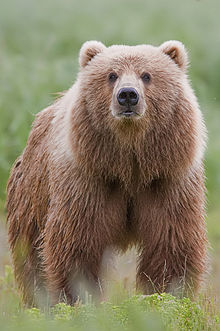
Back Kodiakbeer Afrikaans دب كودياك Arabic دب كودياك ARZ Rupol (Ursus arctos middendorffi) AVK Kadyak ayısı Azerbaijani Кодиакска кафява мечка Bulgarian Os de Kodiak Catalan Ursus arctos middendorffi CEB Medvěd kodiak Czech Kodiakbjørnen Danish
This article may be in need of reorganization to comply with Wikipedia's layout guidelines. (February 2021) |
| Kodiak bear | |
|---|---|

| |
| A bear in Kodiak Island, Alaska, US | |
| Scientific classification | |
| Domain: | Eukaryota |
| Kingdom: | Animalia |
| Phylum: | Chordata |
| Class: | Mammalia |
| Order: | Carnivora |
| Family: | Ursidae |
| Genus: | Ursus |
| Species: | |
| Subspecies: | U. a. middendorffi
|
| Trinomial name | |
| Ursus arctos middendorffi | |

| |
| Kodiak bear range within Alaska | |
The Kodiak bear (Ursus arctos middendorffi), also known as the Kodiak brown bear, sometimes the Alaskan brown bear, inhabits the islands of the Kodiak Archipelago in southwest Alaska.[3] It is one of the largest recognized subspecies or population of the brown bear, and one of the two largest bears alive today, the other being the polar bear.[4][5] They are also considered by some to be a population of grizzly bears.
Physiologically and physically, the Kodiak bear is very similar to the other brown bear subspecies, such as the mainland grizzly bear (Ursus arctos horribilis) and the extinct California grizzly bear (U. a. californicus), with the main difference being size, as Kodiak bears are on average 1.5 to 2 times larger than their cousins. Despite this large variation in size, the diet and lifestyle of the Kodiak bear do not differ greatly from those of other brown bears.
Kodiak bears have interacted with humans for centuries, especially hunters and other people in the rural coastal regions of the archipelago.[6] The bears are hunted for sport and are encountered by hunters pursuing other species. Less frequently, Kodiak bears are killed by people whose property (such as livestock) or person are threatened.[7] In recent history there has been an increasing focus on conservation and protection of the Kodiak bear population as human activity in its range increases.[6] The IUCN classifies the brown bear (Ursus arctos), of which the Kodiak is a subspecies, as being of "least concern" in terms of endangerment or extinction, though the IUCN does not differentiate between subspecies and thus does not provide a conservation status for the Kodiak population. The Alaska Department of Fish and Game however, along with the United States Fish and Wildlife Service to a lesser extent, closely monitor the size and health of the population and the number of bears hunted in the state.[6]
- ^ "IUCN Brown Bear subspecies status". Retrieved August 29, 2022.
- ^ Cite error: The named reference
Merriam1896was invoked but never defined (see the help page). - ^ Cite error: The named reference
factsheetwas invoked but never defined (see the help page). - ^ Cite error: The named reference
fwswas invoked but never defined (see the help page). - ^ Servheen, C.; Herrero, S.; Peyton, B.; Pelletier, K.; Moll, K.; Moll, J., eds. (1999), Bears: status survey and conservation action plan (PDF), vol. 44, Gland, Switzerland: IUCN, archived from the original (PDF) on 2015-09-23, retrieved 2019-11-20
- ^ a b c "Kodiak Archipelago Bear Conservation and Management Plan" (PDF). Alaska Department of Fish and Game. February 2002.
- ^ Barnes, Victor G. (1994). "Brown Bear-Human Interactions Associated with Deer Hunting on Kodiak Island". Bears: Their Biology and Management. 9: 63–73. doi:10.2307/3872685. ISSN 1936-0614. JSTOR 3872685.
© MMXXIII Rich X Search. We shall prevail. All rights reserved. Rich X Search
